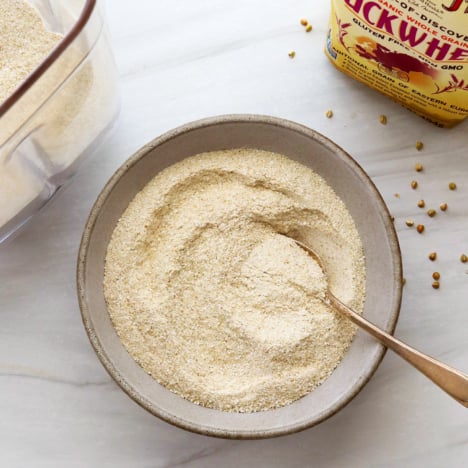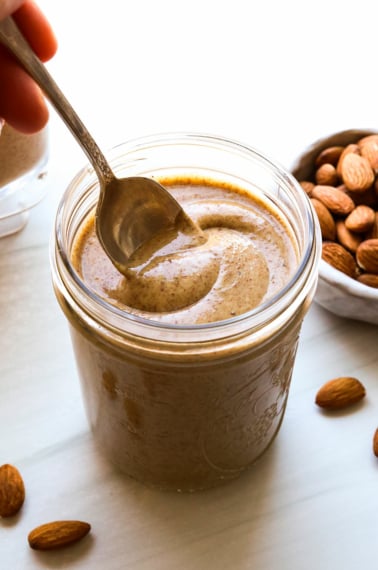This post may contain affiliate links. Please read my disclosure and privacy policy.
Buckwheat flour is a gluten-free alternative to all-purpose flour that’s easy to make at home! It makes amazing cookies, banana bread, waffles, and more.

Despite its name, buckwheat is related to rhubarb, not wheat. It’s a pseudocereal, which means it’s a seed that is consumed like a cereal grain. It’s even considered a whole grain, similar to quinoa!
Unlike other gluten-free flours, buckwheat flour doesn’t need to be combined with other flours or starches in baking. It does have a slightly earthy flavor, but it bakes up quite similarly to wheat flour. If you’ve ever tried soba noodles, you may already be familiar with its taste.
Buckwheat flour should not be used as a 1:1 swap for white flour, but when you use it in a tested recipe, buckwheat flour can create quick breads and muffins that are just as delicious as traditional ones!
If you’re already familiar with popular gluten-free whole grain flours like rice flour and oat flour, buckwheat flour will be a welcome addition to your kitchen pantry!

What to Know About Buying Buckwheat Flour
Buckwheat flour is not always consistent when you buy it at the store. Some brands will have a grayish-blue hue, which typically means the seeds were ground with their hard outer shell (also called hulls). This type of flour is usually more noticeable in flavor when it comes to baking.
If you are hoping to use buckwheat flour in everyday baking, like making a batch of chocolate chip cookies or a loaf of pumpkin bread, look for a flour that is light-colored and made with hulled buckwheat groats.
Anthony’s organic buckwheat flour (affiliate link) is a great option, if you like the convenience of buying it, or you can make it at home in just minutes using the tips below.
How to Make Buckwheat Flour
To make homemade buckwheat flour, add at least 2 cups of buckwheat groats to a high-speed blender. Secure the lid and process until the groats are ground into a very fine texture, similar to flour.
It’s ready to use in just about two minutes of blending.

If you don’t have a high-speed blender on hand, you can also use a coffee grinder to make buckwheat flour, but you’ll need to work in smaller batches.
My coffee grinder can only process a 1/4 cup of groats at once, but it works just as well as the blender, if not better.

Store buckwheat flour in an airtight container for up to a week in a dry place, making sure that no moisture is in the container so it won’t spoil. For the best shelf life, store it in the fridge or freezer and it should last for months.
Frequently Asked Questions
Buckwheat contains all 9 essential amino acids, making it a complete protein. It’s naturally gluten-free and works well for creating fluffy baked goods with a similar texture to wheat flour.
In addition to buckwheat, millet, corn, soy, rice, amaranth, arrowroot, teff, quinoa, and oats are naturally gluten-free. Be sure to carefully read labels when purchasing these grains, to avoid any cross contamination with gluten during the manufacturing process.
Either option is great as long as you start with a recipe that calls for the specific flour you want to use. (Don’t make substitutions and expect amazing results with either flour.) Buckwheat flour will turn out slightly more like all-purpose flour when compared to almond flour in baking.
Buckwheat Flour Recipes to Try
Now that you know how easy it is to make buckwheat flour at home, here are some delicious ways to use it.
- Make Buckwheat Banana Pancakes. This recipe is vegan and can be baked on a sheet pan so they are all ready to eat at the same time.
- Try Vegan Buckwheat Cookies. If you need an egg-free or dairy-free cookie option, these have been a fan favorite for nearly a decade.
- Bake a loaf of Buckwheat Pumpkin Bread. This spiced bread pairs perfectly with the earthy flavor of buckwheat. It tastes like you got it from a coffee shop! If you prefer banana bread, I have you covered, too.
- Whip up a batch of Double Chocolate Buckwheat Cookies. These taste like a brownie, but cook in just a fraction of the time!
- Meal prep batch of Buckwheat Waffles. They turn out crispy and delicious and can be popped into the toaster for a fast morning.
Looking for more easy gluten-free recipes? Try Gluten-Free Pretzels, Healthy Birthday Cake, and the Best Gluten-free Cinnamon Rolls You’ll Ever Eat. (Seriously!)

Ingredients
- 2 cups buckwheat groats (or more, as needed)
Instructions
- Add the buckwheat groats to a high-speed blender and secure the lid. Blend until the groats are pulverized into a very fine texture like flour. This may take up to 2 minutes. You may use more than 2 cups if you need more flour, but don't use less than 2 cups to ensure an even texture.
- If you don't have a high-speed blender, you can use a coffee grinder instead, but you'll need to work with just a 1/4 cup of groats at a time.
- Use the buckwheat flour right away in your favorite buckwheat recipes, or store it in an airtight container in your pantry until you're ready to use it. It should last for at least 3 months, or possibly longer if you store it in the fridge.
Notes
Nutrition
I can’t wait to hear what you make with your homemade buckwheat flour. Let me know in the comments!











